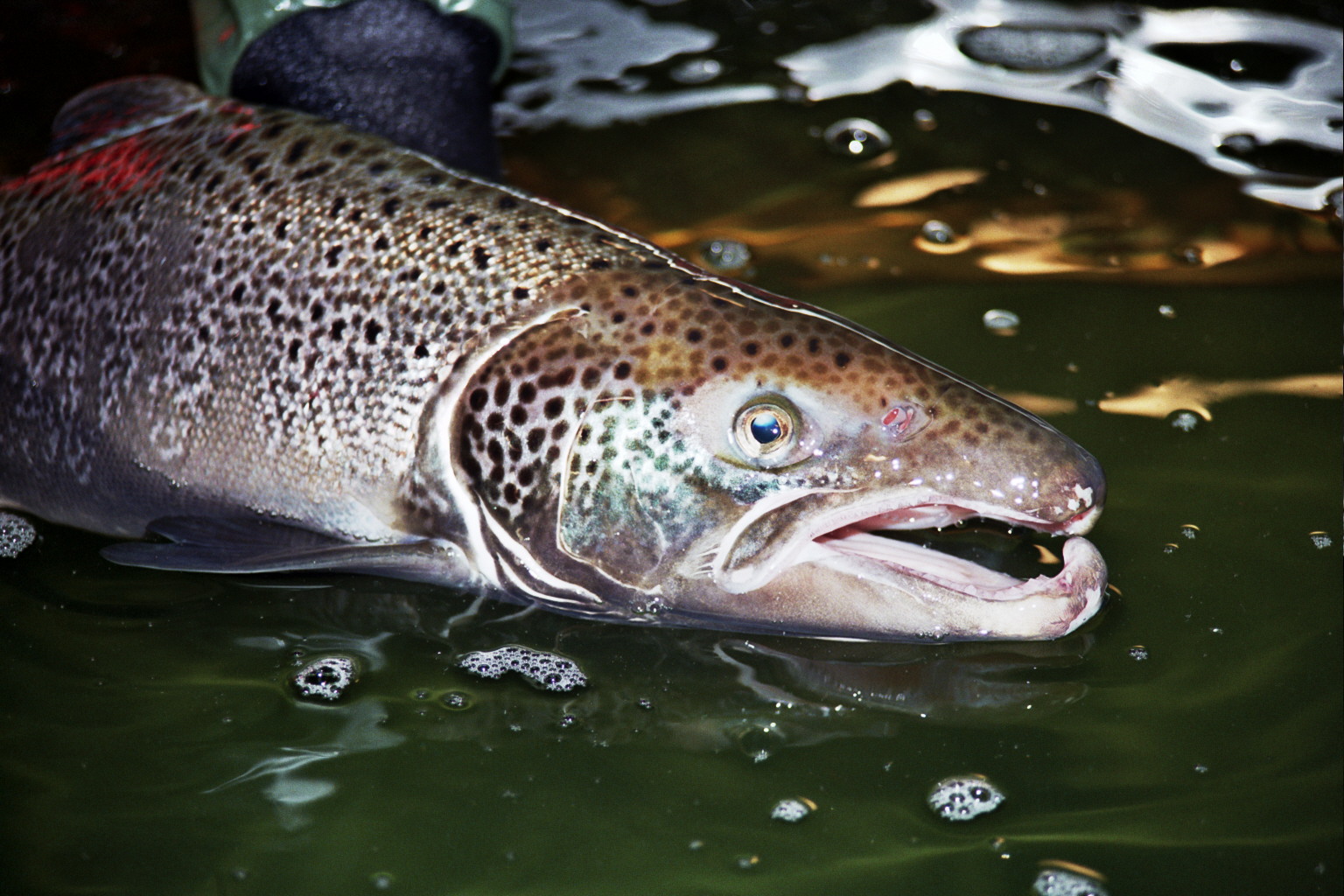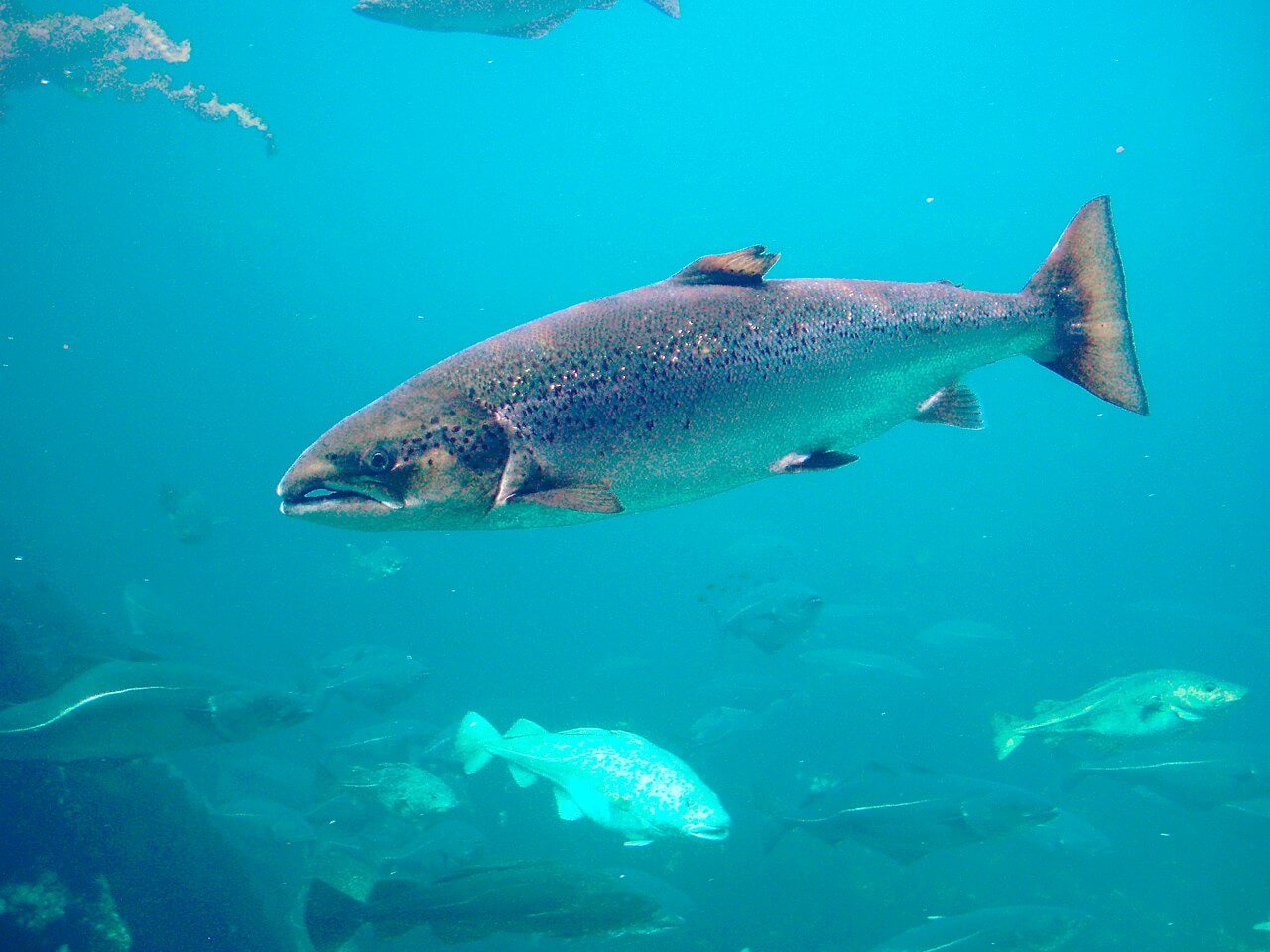
SIZE:
47 cm, up to 150 cm.
LIFE EXPECTANCY:
10 years.
LIFE CYCLE:
Sexual maturity between 3 and 7 years.
Spawning takes place in late autumn. Once back in the waterway of their birth, females dig “nests”. Once the eggs have been fertilized by the male, the female buries them under 12 cm to 15 cm of gravel using her tail. The eggs hatch in early spring.
At around 3 years of age, the young salmon migrate to salt water. They will remain there for 1 to 3 years, before returning to fresh water to spawn.
Most salmon die after spawning, but a small percentage of females return to the sea.

Atlantic salmon develop a hooked jaw during the breeding season.
Credit : E. Peter Steenstra/USFWS, photo taken in Maine in 2006.
Atlantic salmon has a long body. It has a large mouth that extends to right below the eyes. The male’s lower jaw forms a hook as it prepares to reproduce. It is sometimes so large that it can pierce the palate. Its caudal fin is broad, concave, and forked. Its back is blue-green, the flanks are silvery, with round or “x”-shaped spots. Its belly is white. As salmon grows, its color changes.
Salmon scales are like tree rings. They can be used to determine a fish’s age and the number of times it has spawned.
In the water column, at shallow depths.
Its habitat varies throughout its life. Salmon live in saltwater and migrate to freshwater to reproduce. It is an anadromous fish.
Atlantic salmon live in rivers which have a good oxygen supply, a gravel or rocky bed, and a relatively strong current.
PREYS:
Plankton
Larvae of fish
Small fish
Crustaceans
PREDATORS:
Seals
Seabirds
MACHINES:
Aquaculture.
REGULATIONS:
Commercial fishing has been banned in Canada since 1998. The salmon’s biomass has a status of concern, even that of endangered, depending on the population.
Salmon is of economic and cultural importance for the Mi’gmaq of Gesgapegiag and Gespeg, in the Gaspé Peninsula, and for the Wolsatoqiyik Wahsipekuk First Nation, in the Lower St. Lawrence.
These communities fish this species for community and recreational purposes. This practice is part of their traditions.
Beyond the basins
Salmon is a species particularly well-suited to aquaculture, as it adapts quickly to farming conditions. However, farming does have its drawbacks. The chemicals, anti-biotics and anti-parasitics used in farming end up in the surrounding waters. What’s more, in addition to caring for these salmon, they have to be fed. It would take 3 kg of fish to produce 1 kg of farmed salmon.
BENEFITS:
Salmon is a fatty fish, rich in protein, Omega-3, and lipids.
LET’S COOK:
Firm, moist texture. Very refined, slightly sweet and oily taste. Smooth, pink flesh.
Salmon is very versatile and has already earned its place in our kitchens. It can be pan-fried, baked, smoked; served as a burger, gravlax, sushi, and more.
OUR CULINARY ADVICE :
- Find out where your salmon comes from before you buy it. Avoid salmon raised in “open nets”. This type of farming has a greater impact on the surrounding environment.
- Baking is the easiest way for the uninitiated. It is best to keep the skin on to prevent the fish from drying out. Bake for 15 to 20 minutes at 200 °C (400 °F), with a bit of lemon, pepper, and salt.
- For the more experienced, poached salmon may be more complicated to prepare, but is healthier. The salmon is cooked in a pan, covered with broth. For best results, the stock should be simmering, not boiling. Our little plus? Flavor this decoction with algae.
Wild or farmed?
Compared to farmed salmon, wild salmon has less fatty flesh and is slightly paler in color. This is due to the difference in its diet. However, given the ban on commercial fishing in Canada, you will find mostly farmed salmon in grocery stores.





